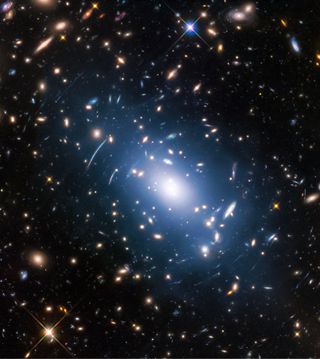Dark Matter Can Be Mapped by Light of Unmoored Stars

There's a new way to map the distribution of mysterious dark matter.
Stars that have been torn from their natal galaxies and now float within huge galaxy clusters can serve as dark-matter probes, a new study suggests.
"We have found a way to 'see' dark matter," study lead author Mireia Montes, of the University of New South Wales in Australia, said in a statement. "We have found that very faint light in galaxy clusters, the intracluster light, maps how dark matter is distributed." [The Search for Dark Matter in Pictures]
Dark matter is about six times more abundant throughout the universe than the "normal stuff" that makes up you and me, rocks, trees, planets, and stars. But dark matter remains difficult to study, because, as its name suggests, the substance does not emit light of any kind. Scientists can confirm its presence only indirectly, generally via gravitational effects on normal matter.
For example, astronomers map dark-matter distribution in massive galaxy clusters by studying how the clusters distort the light of objects behind them, a phenomenon known as gravitational lensing. But such work is complex and time-consuming, said Montes and co-author Ignacio Trujillo, of the Instituto de Astrofísica de Canarias in Spain.
The researchers think the stars beaming out the intracluster light provide a better method, coming to this conclusion after analyzing Hubble Space Telescope imagery of six different galaxy clusters.
"These stars have an identical distribution to the dark matter, as far as our current technology allows us to study," Montes said.
Get the Space.com Newsletter
Breaking space news, the latest updates on rocket launches, skywatching events and more!

The relative ease with which intracluster light can be studied — all you need is deep-field imagery — means that researchers could extend the data set far beyond six galaxy clusters in the relatively near future, Montes and Trujillo said. Such work could be done by Hubble as well as future instruments, including NASA's $8.8 billion James Webb Space Telescope, which is scheduled to launch in March 2021, the researchers added.
"There are exciting possibilities that we should be able to probe in the upcoming years by studying hundreds of galaxy clusters," Trujillo said in the same statement.
The new study was published online Oct. 23 in the journal Monthly Notices of the Royal Astronomical Society.
Mike Wall's book about the search for alien life, "Out There" (Grand Central Publishing, 2018; illustrated by Karl Tate), is out now. Follow him on Twitter @michaeldwall. Follow us @Spacedotcom or Facebook. Originally published on Space.com.
Join our Space Forums to keep talking space on the latest missions, night sky and more! And if you have a news tip, correction or comment, let us know at: community@space.com.

Michael Wall is a Senior Space Writer with Space.com and joined the team in 2010. He primarily covers exoplanets, spaceflight and military space, but has been known to dabble in the space art beat. His book about the search for alien life, "Out There," was published on Nov. 13, 2018. Before becoming a science writer, Michael worked as a herpetologist and wildlife biologist. He has a Ph.D. in evolutionary biology from the University of Sydney, Australia, a bachelor's degree from the University of Arizona, and a graduate certificate in science writing from the University of California, Santa Cruz. To find out what his latest project is, you can follow Michael on Twitter.
